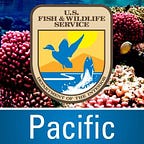Hawai‘i’s Seabirds Need Your Help During Fallout Season
By Nanea Valeros, Public Affairs Specialist, U.S. Fish and Wildlife Service
Every fall, Hawai‘i’s young seabirds leave their nests for their first flight to the ocean. On their way to the ocean, they can become disoriented by artificial lights, collide with structures, or become exhausted and “fallout” where they are at risk of being hit by cars or harmed by predators like cats, dogs, rats, or mongooses.
During fallout season (September 15 to December 15), people can help seabirds by keeping pet cats indoors; keeping pet dogs on a leash when walking; turning off or minimizing outdoor lighting; replacing outdoor lighting fixtures with seabird friendly lighting; closing window curtains at night; and keeping an eye out for seabirds that may need assistance.
Across Hawai‘i, the State of Hawaiʻi Department of Land and Natural Resources (DLNR), Division of Forestry and Wildlife (DOFAW), U.S. Fish and Wildlife Service, and licensed wildlife rehabilitation organizations like Save Our Shearwaters and the Hawai‘i Wildlife Center work together to protect those birds that need help during fallout season.
Juvenile seabirds fledge (leave their nests) each year from September to December. While fallout can affect adult birds year round, young birds leaving their nests for the first time are most at risk. Petrels and shearwaters use the moon to navigate from their nests to the ocean. Artificial lights can cause these birds to be disoriented — they may circle artificial lights until they become exhausted or collide with structures. Once seabirds are on the ground, they are at risk of being injured or killed by predators like cats or run over by vehicles.
There are over 20 species of seabirds in Hawai‘i, but particular species of concern during fallout season are the federally threatened ‘a‘o (Newell’s shearwater), federally endangered ‘ua‘u (Hawaiian petrel), and the ‘ua‘u kani (wedge-tailed shearwater) — a species federally protected under the Migratory Bird Treaty Act.
Here is a list of steps you can take if you find a downed seabird:
- Determine if it needs to be rescued. Observe the bird for at least 10 minutes before taking any action. Young birds often stay near their nest burrows and do not need intervention. These birds will not need to be rescued and should be left alone. If the bird appears not to be moving or is in an unsafe area like near a road or where cats, dogs, or other predators may injure or kill them, it may need to be rescued and brought to a local organization that specializes in helping seabirds.
- Find and prepare an appropriate sized, well ventilated carrier (with air holes) such as a cardboard box, by placing a clean, soft cloth (for example, a T-shirt) at bottom of carrier.
- With caution, approach bird from behind and use a lightweight towel to gently pick it up and transport it to the carrier.
- Place the carrier in a quiet and dark place, away from people, animals, and loud noises.
- Do not give food or water to the bird and do not leave any in the carrier.
- Note the time and location of where you found the bird.
- Transport the bird to a designated drop off location or licensed wildlife rehabilitation facility. Birds can be held overnight if transportation to a drop off location is not immediately available. Keep the carrier inside or in an enclosed garage away from people and animals until it can be transported.
If you are uncertain the bird needs help or you have questions regarding seabird fallout, please call the DLNR DOFAW office for your island. If dropping off a downed seabird (always call ahead) see this list for nearest location, or call the Hawai‘i Wildlife Center if you’re unable to reach the nearest facility. Any after-hours calls will be returned the following morning.
The U.S. Fish and Wildlife Service works with others to conserve, protect, and enhance fish, wildlife, plants, and their habitats for the continuing benefit of the American people. For more information, connect with us through any of these social media channels at https://www.facebook.com/PacificIslandsFWS, www.flickr.com/photos/usfwspacific/, or www.twitter.com/USFWSPacific.
